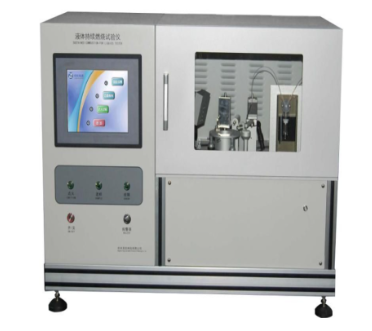Time: Popularity:0times
When the hazardous liquid is heated to 0.5 ºC and 75 ºC, flame durability tester is used to evaluate the continuous burning time. When the subject material is heated and exposed to fire according to test conditions, this instrument can test its continuous burn time.
1. Meltblown filter material is tested using a heat source with a standard energy level to observe its combustion behavior. The energy of the flame source is determined by measuring the flame height and temperature.
2. The time the meltblown filter material or other sample passes through the flame source is specified by the standard. The flame exposure time is ensured by controlling the movement speed of the mask.
3. The sample's combustion behavior is measured by both flaming and flameless combustion.
1. Pre-Test System Preparation
Before testing, ensure the laboratory environment meets standard requirements. The temperature should be strictly controlled within the range of 23 ± 2°C, and the relative humidity should be maintained between 45% and 75%. The laboratory must be equipped with an effective exhaust system, but the exhaust speed must not exceed 0.2 m/s to avoid affecting flame stability.
Equipment calibration is critical to ensuring test accuracy. First, use a dedicated gauge to calibrate the flame height to ensure it is precisely controlled within the standard range of 12 ± 1 mm. Regarding temperature calibration, it is recommended to verify the thermocouples quarterly using a standard temperature source to ensure accurate temperature measurement.
Specimen preparation requires special attention. The standard sample size should be no less than 100 mm x 100 mm, and at least three replicate samples should be prepared for each test. All samples must remain in the test environment for at least 24 hours to eliminate the effects of environmental stress on the test results.
2. Key Controls During the Test
At the beginning of the test, the equipment must be preheated for 15 minutes to achieve stable conditions. Ensure the sample is securely mounted to prevent movement during testing. Pay special attention to flame position calibration, ensuring the flame maintains a standard 45° or perpendicular angle with the sample surface.
During the test, three key indicators should be observed: First, the burning duration, accurately recording the entire time from flame contact to sample self-extinguishing. Second, closely observe for the generation of burning drips and whether these drips ignite the underlying standard gauze. Finally, accurately measure the sample's burn length with an accuracy of 0.5mm.
3. Data Recording Requirements
Complete data recording should include key parameters such as the precise time of flame application, sample self-extinguishing time, and combustion spread. It is recommended to use a high-definition camera for full recording, with a frame rate of at least 30 fps. Where possible, an electronic data acquisition system is recommended to avoid errors caused by manual recording.
1. Common Flame System Issues
A yellow and unstable flame is usually caused by insufficient gas purity or a clogged nozzle. The solution is to switch to high-purity propane fuel and clean the nozzle with a dedicated needle. If significant fluctuations in flame height are observed, check the pressure setting of the pressure reducing valve and adjust it to the standard range of 0.1±0.01 MPa.
Automatic ignition system failures are often caused by carbon deposits on the ignition electrodes. The solution is to clean the electrodes with alcohol wipes and ensure that the electrode spacing remains within the standard range of 3-5 mm. It is important to note that frequent ignition failures may indicate a leak in the gas pipeline, which requires a systematic inspection.
2. Analysis of Abnormal Test Data
When test results fluctuate abnormally, the first step is to investigate the sample. For example, a laboratory discovered large data dispersion when testing PP material. This was attributed to uneven sample thickness. Adjusting the thickness to 1.0±0.1 mm resolved the issue. Environmental factors are also important. One laboratory experienced test results that deviated by more than 15% from those of the certification body due to excessive humidity. These results were restored to normal after installing dehumidification equipment.
3. Safety Emergency Procedures
In the event of an emergency, immediately press the emergency stop button to shut off the gas supply. Burning samples should be covered with a dedicated fire blanket; water-based fire extinguishing agents are strictly prohibited. Laboratories must be equipped with professional protective equipment such as flame-retardant gloves and auto-darkening welding masks that meet EN407 standards, and the effectiveness of CO2 fire extinguishers must be regularly checked.
1. Daily Maintenance Key Points
After daily testing, thoroughly clean the combustion chamber with a copper scraper. Leak detection should be performed weekly on the gas pipeline, and all connections should be checked with a dedicated leak detector. Lubricate and maintain moving parts monthly, paying particular attention to precision components such as the adjusting screw.
2. Regular Deep Maintenance
Systematic accuracy verification should be performed quarterly, including flame temperature calibration and timing accuracy testing. Comprehensive preventive maintenance should be performed annually by professional technicians, including electrical system inspections and gas system maintenance. It is recommended to maintain a complete equipment maintenance log, documenting the details of each maintenance session and any issues discovered.
3. Key Component Replacement Cycles
Nozzles, as consumable parts, are recommended to be replaced every 5.000 tests or every six months. The typical service life of a thermocouple is one year and should be replaced promptly. The backup battery in the control system needs to be replaced every two years to prevent data loss.

Company Phone
+86-21-6420 0566
Working hours
Monday to Friday
Mobile phone:
13816217984
Email:
info@qinsun-lab.com
